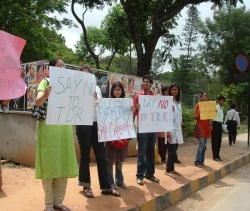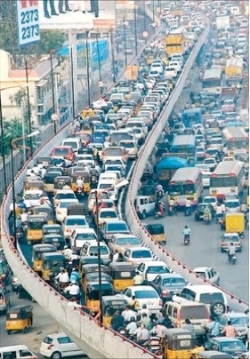Public Action on Road Widening
Download the pdf version here.
1. My house/shop has been marked [e.g.; +6 .0 m, +7.8 m] by BBMP. What does this mean?
The marking on your property has been made as part of the BBMP’s survey of the extent to which your property will be required for widening the road. A marking of ‘+6.0 m’ or ‘+7.8 m’ in red on your compound wall means that the set back of your property will be shifted back to this extent, to make way for the road.

2. Should they have asked me when they marked my property?
The process of planning roads and widening them is a detailed in the Karnataka Municipal Corporation Act, Karnataka Town and Country Planning Act and related legislations. It is a very involved process requiring a series of proposals, public consultations, notifications, scheme formulations and finalization by way of notification. The entire process has to be done in a very public and transparent manner as per the law. The current action of the BBMP to mark properties on the basis of a notification issued proposing widen roads as per S.14(b) of the Town and Country Planning Act is a blatant violation of Law. In fact, even if the BBMP had conformed fully to the procedure laid out in the aforesaid acts, it does not have the right to mark your properties as it has now done. Any acquisition of property has to be done by issue of a proper notice as per the procedure laid out in law and not by causing mental harassment by marking people’s properties.
Since it is illegal to have marked your property in the manner that has now been done, you are at liberty to file a criminal complaint against the BBMP in your local Police Station for vandalizing your property.
3. Can the BBMP throw me out without warning if my property is marked?
No, you cannot be evicted from your property based on the illegal marking.
In case the BBMP has complied with the procedure laid out above it can widen roads only when there is a voluntary surrender of land under the TDR scheme (Section 14(b) of the KTCP Act). If one does not opt for TDR the only other option is to acquire your property as per the Land Acquisition Act, 1894 or the Karnataka Industrial Area Development Board Act (If specially invoked for this road widening scheme)
4. My property has not been marked but other properties in my locality have been marked. Does this mean my property is safe? How do I find out for sure?
The notification that has now been issued as under Section 14(b) of the KTCP Act offers TDR rights to property owners. This is not a notification for implementing the road-widening project.
Whether or not your property is marked (illegally) indicating the extent to which it is to be acquired for road widening, your property is at risk till such time the intent to widen roads exist. It is possible to confirm if a property is threatened by acquisition by approaching the BBMP, and they are bound to provide all the details.
5. Someone told me they are giving me TDR instead of compensation. What does this mean?
TDR refers to Transferable Development Rights that was introduced by the 2005 amendment to the Town and Country Planning Act. The TDR scheme does not involve any monetary compensation or rehabilitation benefits whatsoever.

6. What are details of the TDR scheme?
When the owner surrenders a part of his property voluntarily to the BBMP/BDA or any such agency for road widening, s/he shall be entitled to development rights by way of additional Floor Area Ratio (FAR) to the extent of one and half times of the area of land surrendered. This developmental right is given to him/her in the form of a Development Rights Certificate (DRC).
Example 1:
If your plot measures 500 square metres and your FAR* is 1.5 then you can construct a building with a floor area of 750 sq.m. (The FAR for each layout depends upon the zoning regulations in that area.) If you voluntarily give up 100 sq. m to the BBMP for road widening you will be allowed to have an additional built-up area of 150 square metres. Hence, now you will be allowed to build 750+150= 900 sq.m upon a 500-100=400 sq.m plot of land.
Example 2:
Plot area500 sqmFAR*0.75Built-up area500 x 0.75 sqm = 375 sqmArea surrendered100 sqmPlot area after surrender500 – 100 = 400 sqmAdditional floor area given in the form of developmental rights1.5 x 100 = 150 sqmBuildable floor area in remaining plot area
a. if Additional Floor area is utilized in the same plot
375 + 150 = 525 sqm
b. Area that can be traded on the market as DRC
150 sqm
*FAR = Built-up area : Plot area
This additional development right may be used for the remaining portion of the property or can be used by the same property owner on any other property held in the city within BBMP limits or can be sold at prevailing market rates to any other property owner to be utilized as an additional building right on their property. Such measures are subject to local zoning regulations.
7. Is TDR voluntary or compulsory?
TDR, as laid down in the Town and Country Planning Act a barter of building rights in exchange for voluntary surrender of land for a stated public purpose. TDR cannot be forced on anyone and is therefore not compulsory.
- It is not an offence to refuse TDR.
- There is no power latent with the government on any property owner. Even if 99% of the property owners have accepted TDR and you have refused the government does not have the power to compel you to surrender your property under the TDR scheme.
8. In case I/We do not accept the TDR, what then can the government do to acquire my property?
The government has only one option left, which is to initiate land acquisition proceedings as per the Land Acquisition Act or the KIADB Act (if specially invoked for the road widening project). This is a fairly involved process requiring direct intimation to the property owner, opportunities of hearings, potential to object etc. A major pitfall of the land acquisition process is that the government has the superior right of ignoring objections under the principle of eminent domain, which is normally sustained by courts. A major possibility of ensuring land acquisition proceedings are not initiated is by organizing communities to lobby their elected representatives and the government to ensure that land acquisition proceedings are not initiated.
9. What can I do to protect my property?
As a legally bonafide owner of your property the State can only dispossess you under the due process of law as laid out in legislations relating to land acquisition.
At this point the following options exist to protect your property:
- Refuse to accept TDR
- Monitor land acuisition proceedings and in case your property is notified for acquisition move immediately as per opportunities latent in the law to drop such acquisition
- Work with other affected owners and tenants to advance other options of redeeming the traffic situation so that road widening becomes unnecessary
- Demand public accountability of implementing agencies in strictly following the provisions of the KTCP Act, KMC Act, KTP Act and other legislations as directed by the Hon’ble High Court of Karnataka.
10. What makes the BBMP’s road widening scheme illegal?
The Bruhat Bangalore Mahanagara Palike proposes to widen over a 100 roads in the city of Bangalore. All such road-widening schemes are illegal because they have not complied with the KTCP Act, in particular:
- No notification has been made in the draft CDP proposing an increase in the right of way. As a result merely confirming an increase in right of way in the final CDP is in blatant violation of the provisions of the KTCP Act.
- The BBMP has rushed to implement the road-widening scheme when the BDA is yet to comply with chapter V of the KTCP Act wherein a scheme to implement road widening has to be formulated based on public consultation. Since such a scheme has not been formulated by the BDA as yet, the act of BBMP marking your property exhibiting an interest to acquire it is illegal.
- It is only after the BDA has formulated a scheme could the BBMP have initiated steps to implement the project. It is at this time that S.14(b) of the KTCP Act should have been invoked. Whereas disregarding and violating all other provisions and procedures BBMP has rushed to implement the road-widening project based on the highly illegal act of issuing TDR notifications.
- In conformance with the directions of the Hon’ble High Court of Karnataka in WP 7107/08, BBMP and all other agencies implementing road widening works are required to ‘strictly follow’ the provisions of the Karnataka Town and Country Planning Act and the Karnataka Preservation of Trees Act. When thereby trees are felled on account of road widening and properties notified for that purpose without conforming to the direction of the court, the actions are clearly in contempt of court.

11. Is this road widening necessary? Will it stop congestion?
Road widening will not solve Bangalore’s traffic woes. An examination of the data for Bangalore’s vehicular population reveals that the number of vehicles in Bangalore doubles every five years. 90% of Bangalore’s vehicular population is two wheelers and cars. There is no way that road widening can keep up with this growth in vehicular population. The only long-term solution for the city’s traffic woes is to consciously promote public transport and reduce the reliance on private vehicles.
The road widening scheme will result in the loss of the larger part of the city’s green cover, loss of thousands of livelihoods in commercial areas where properties are located, dislocation of houses and extreme inconvenience to pedestrians, senior citizens, school children and other road users with special needs.
Widening one km. of a road costs a minimum of 8-10 crores for civil works alone and does not at all include the cost of acquisition, compensation for rehabilitation, shifting utilities and such other costs. By a very conservative estimate, if all 100 roads were widened, it would amount to over 400 kilometres of road length being widened. The civil works cost of such an effort would be a minimum of 4000 crores at current prices making it a stupendously expensive project.
Considering that viable alternatives can be executed to limit the need for widening roads and since such alternatives have not at all been explored, it becomes essential for each and every one of us to hold our local authorities and state government accountable to ensure such projects are not implemented in haste, irrationally, and in violation of fundamental rights. In fact the National Urban Transport Policy of the Government of India categorically states that ‘measures that allocate road space on a more equitable basis, with people as the focus’ is one of its primary objectives. The policy clearly discourages widening as a solution to congestion as it lays down “Willingness to divert funds from projects that add to road capacity towards public transit systems” as one of the parameters determining the Central Government’s decisions of providing financial assistance to State projects.
12. I recently read about a High Court order allowing BBMP to carry on road widening? What does it mean?
Environment Support Group and others filed Public Interest Litigation in 2008 before the High Court of Karnataka challenging the legality of the road widening project. The High Court in its order dated March 16th, 2009 has made it clear that if the corporation wants to carry on road widening works it an only do so in strict compliance with the Karnataka Town and Country Planning Act and the Karnataka Preservation of Trees Act.

